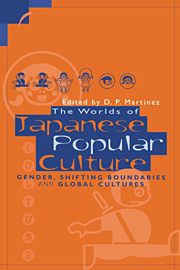Gender, Shifting Boundaries and Global Cultures
Published online by Cambridge University Press: 22 September 2009
Summary
Japanese popular culture is so rich and varied that no single book could do justice to it, and this volume is only one recent attempt to describe the “worlds” to be found under the deceptively simple heading of “popular culture”. The chapters in this book present a variety of topics, ranging from traditional sumo to the more recently successful introduction of football. The book's contributors include Japanese as well as British, Icelandic and North American writers, all of whom offer a diversity of views of what Japanese popular culture is and how it is best approached and understood. The unity of the book lies in its predominantly anthropological approach – of the ten contributors five are anthropologists; the others include a linguist, two experts on literature, a journalist and a film theorist – and in its implicit assumption that Japan is the unit of analysis. But, we might ask, as Yoshio Sugimoto did in the first book of this series (1997): which Japan? Male manager-dominated middle-class Japan? The Japan of the Kantô region, dominated by Tokyo, or the Japan of the Kansai region where Osaka and Kyoto are the important cities? Is it urban Japan or rural Japan, the Japan of small nuclear families or of the single young woman? Is there one Japanese society? The essays in this book argue against the view of a single Japanese culture.
- Type
- Chapter
- Information
- The Worlds of Japanese Popular CultureGender, Shifting Boundaries and Global Cultures, pp. 1 - 18Publisher: Cambridge University PressPrint publication year: 1998
- 12
- Cited by

